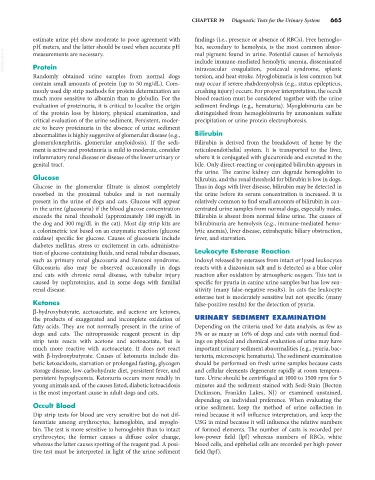Page 693 - Small Animal Internal Medicine, 6th Edition
P. 693
CHAPTER 39 Diagnostic Tests for the Urinary System 665
estimate urine pH show moderate to poor agreement with findings (i.e., presence or absence of RBCs). Free hemoglo-
pH meters, and the latter should be used when accurate pH bin, secondary to hemolysis, is the most common abnor-
VetBooks.ir measurements are necessary. mal pigment found in urine. Potential causes of hemolysis
include immune-mediated hemolytic anemia, disseminated
Protein
torsion, and heat stroke. Myoglobinuria is less common but
Randomly obtained urine samples from normal dogs intravascular coagulation, postcaval syndrome, splenic
contain small amounts of protein (up to 50 mg/dL). Com- may occur if severe rhabdomyolysis (e.g., status epilepticus,
monly used dip strip methods for protein determination are crushing injury) occurs. For proper interpretation, the occult
much more sensitive to albumin than to globulin. For the blood reaction must be considered together with the urine
evaluation of proteinuria, it is critical to localize the origin sediment findings (e.g., hematuria). Myoglobinuria can be
of the protein loss by history, physical examination, and distinguished from hemoglobinuria by ammonium sulfate
critical evaluation of the urine sediment. Persistent, moder- precipitation or urine protein electrophoresis.
ate to heavy proteinuria in the absence of urine sediment
abnormalities is highly suggestive of glomerular disease (e.g., Bilirubin
glomerulonephritis, glomerular amyloidosis). If the sedi- Bilirubin is derived from the breakdown of heme by the
ment is active and proteinuria is mild to moderate, consider reticuloendothelial system. It is transported to the liver,
inflammatory renal disease or disease of the lower urinary or where it is conjugated with glucuronide and excreted in the
genital tract. bile. Only direct-reacting or conjugated bilirubin appears in
the urine. The canine kidney can degrade hemoglobin to
Glucose bilirubin, and the renal threshold for bilirubin is low in dogs.
Glucose in the glomerular filtrate is almost completely Thus in dogs with liver disease, bilirubin may be detected in
resorbed in the proximal tubules and is not normally the urine before its serum concentration is increased. It is
present in the urine of dogs and cats. Glucose will appear relatively common to find small amounts of bilirubin in con-
in the urine (glucosuria) if the blood glucose concentration centrated urine samples from normal dogs, especially males.
exceeds the renal threshold (approximately 180 mg/dL in Bilirubin is absent from normal feline urine. The causes of
the dog and 300 mg/dL in the cat). Most dip strip kits are bilirubinuria are hemolysis (e.g., immune-mediated hemo-
a colorimetric test based on an enzymatic reaction (glucose lytic anemia), liver disease, extrahepatic biliary obstruction,
oxidase) specific for glucose. Causes of glucosuria include fever, and starvation.
diabetes mellitus, stress or excitement in cats, administra-
tion of glucose-containing fluids, and renal tubular diseases, Leukocyte Esterase Reaction
such as primary renal glucosuria and Fanconi syndrome. Indoxyl released by esterases from intact or lysed leukocytes
Glucosuria also may be observed occasionally in dogs reacts with a diazonium salt and is detected as a blue color
and cats with chronic renal disease, with tubular injury reaction after oxidation by atmospheric oxygen. This test is
caused by nephrotoxins, and in some dogs with familial specific for pyuria in canine urine samples but has low sen-
renal disease. sitivity (many false-negative results). In cats the leukocyte
esterase test is moderately sensitive but not specific (many
Ketones false-positive results) for the detection of pyuria.
β-hydroxybutyrate, acetoacetate, and acetone are ketones,
the products of exaggerated and incomplete oxidation of URINARY SEDIMENT EXAMINATION
fatty acids. They are not normally present in the urine of Depending on the criteria used for data analysis, as few as
dogs and cats. The nitroprusside reagent present in dip 3% or as many as 16% of dogs and cats with normal find-
strip tests reacts with acetone and acetoacetate, but is ings on physical and chemical evaluation of urine may have
much more reactive with acetoacetate. It does not react important urinary sediment abnormalities (e.g., pyuria, bac-
with β-hydroxybutyrate. Causes of ketonuria include dia- teriuria, microscopic hematuria). The sediment examination
betic ketoacidosis, starvation or prolonged fasting, glycogen should be performed on fresh urine samples because casts
storage disease, low-carbohydrate diet, persistent fever, and and cellular elements degenerate rapidly at room tempera-
persistent hypoglycemia. Ketonuria occurs more readily in ture. Urine should be centrifuged at 1000 to 1500 rpm for 5
young animals and, of the causes listed, diabetic ketoacidosis minutes and the sediment stained with Sedi-Stain (Becton
is the most important cause in adult dogs and cats. Dickinson, Franklin Lakes, NJ) or examined unstained,
depending on individual preference. When evaluating the
Occult Blood urine sediment, keep the method of urine collection in
Dip strip tests for blood are very sensitive but do not dif- mind because it will influence interpretation, and keep the
ferentiate among erythrocytes, hemoglobin, and myoglo- USG in mind because it will influence the relative numbers
bin. The test is more sensitive to hemoglobin than to intact of formed elements. The number of casts is recorded per
erythrocytes; the former causes a diffuse color change, low-power field (lpf) whereas numbers of RBCs, white
whereas the latter causes spotting of the reagent pad. A posi- blood cells, and epithelial cells are recorded per high-power
tive test must be interpreted in light of the urine sediment field (hpf).

